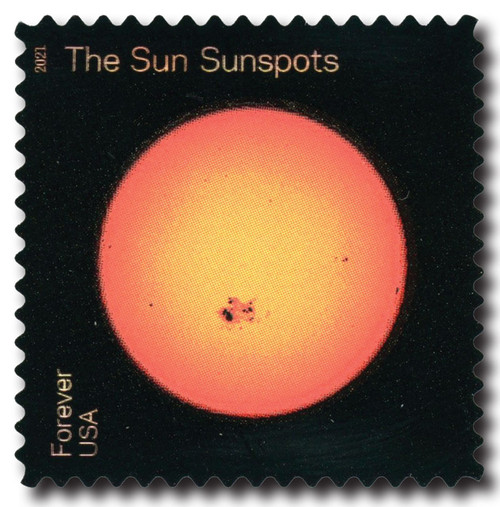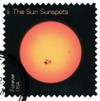
# 5604 - 2021 First-Class Forever Stamp - Sun Science: Sunspots
US #5604
2021 Sunspots – Sun Science
- Pictures sunspots on the sun
- One of 10 stamps in the Sun Science set
Stamp Category: Commemorative
Set: Sun Science
Value: 55¢ First Class Mail Rate (Forever)
First Day of Issue: June 18, 2021
First Day City: Greenbelt, Maryland
Quantity Issued: 18,000,000
Printed by: Banknote Corporation of America
Printing Method: Flexographic, Foil Stamping
Format: Panes of 20
Tagging: Phosphor, block tag
Why the stamp was issued: To showcase the powerful and mysterious science behind the functioning of our sun.
About the stamp design: Pictures a colorized images from NASA’s Solar Dynamics Observatory of sunspots on the sun. According to NASA, the color of this stamp represents an image of the sun as viewed with “visible light – the type of light we can see.”
First Day City: The First Day of Issue Ceremony was held at Greenbelt Main Post Office. It was originally to be held at the NASA Goddard Space Flight Center, but was moved due to observance of the Juneteenth Federal Holiday and the facility being closed.
About the Sun Science set: Includes 10 stamp designs picturing different details of our sun along with phenomena associated with it. Each design pictures a colorized image from NASA’s Solar Dynamics Observatory. The different colors represent a different wavelength that reveals or highlights a particular aspect of our sun.
History the stamp represents: If you’ve heard of sunspots, you may wonder what they actually are. These spots are caused by areas of lower temperature on the Sun’s surface. Since these cooler regions are not as bright as the surrounding areas, they appear as dark spots. (If it were possible to separate sunspots from the Sun’s surface, they would shine brighter than the full moon.)
The first recorded sunspot observations were in China before 800 BC. Since then, scientists have found that the number, size, and location of sunspots vary throughout the Sun’s 11-year solar cycle. They can be as small as 10 miles across or as wide as 100,000 miles. Some larger sunspots can even be seen without a telescope – though you still need to look through a solar filter to avoid damaging your eyes. Sunspots may last anywhere from a few days to several months.
Sunspots occur in areas of significant magnetic activity and are often seen in conjunction with other solar phenomena. This includes coronal loops, solar flares, and coronal mass ejections. Scientists are able to use the study of sunspots to better predict space weather caused by these corresponding events. Some of this weather can even impact Earth. For example, members of the amateur radio community love increased sunspot activity as it leads to increased radio range. It’s amazing what our Sun can do from so far away!
US #5604
2021 Sunspots – Sun Science
- Pictures sunspots on the sun
- One of 10 stamps in the Sun Science set
Stamp Category: Commemorative
Set: Sun Science
Value: 55¢ First Class Mail Rate (Forever)
First Day of Issue: June 18, 2021
First Day City: Greenbelt, Maryland
Quantity Issued: 18,000,000
Printed by: Banknote Corporation of America
Printing Method: Flexographic, Foil Stamping
Format: Panes of 20
Tagging: Phosphor, block tag
Why the stamp was issued: To showcase the powerful and mysterious science behind the functioning of our sun.
About the stamp design: Pictures a colorized images from NASA’s Solar Dynamics Observatory of sunspots on the sun. According to NASA, the color of this stamp represents an image of the sun as viewed with “visible light – the type of light we can see.”
First Day City: The First Day of Issue Ceremony was held at Greenbelt Main Post Office. It was originally to be held at the NASA Goddard Space Flight Center, but was moved due to observance of the Juneteenth Federal Holiday and the facility being closed.
About the Sun Science set: Includes 10 stamp designs picturing different details of our sun along with phenomena associated with it. Each design pictures a colorized image from NASA’s Solar Dynamics Observatory. The different colors represent a different wavelength that reveals or highlights a particular aspect of our sun.
History the stamp represents: If you’ve heard of sunspots, you may wonder what they actually are. These spots are caused by areas of lower temperature on the Sun’s surface. Since these cooler regions are not as bright as the surrounding areas, they appear as dark spots. (If it were possible to separate sunspots from the Sun’s surface, they would shine brighter than the full moon.)
The first recorded sunspot observations were in China before 800 BC. Since then, scientists have found that the number, size, and location of sunspots vary throughout the Sun’s 11-year solar cycle. They can be as small as 10 miles across or as wide as 100,000 miles. Some larger sunspots can even be seen without a telescope – though you still need to look through a solar filter to avoid damaging your eyes. Sunspots may last anywhere from a few days to several months.
Sunspots occur in areas of significant magnetic activity and are often seen in conjunction with other solar phenomena. This includes coronal loops, solar flares, and coronal mass ejections. Scientists are able to use the study of sunspots to better predict space weather caused by these corresponding events. Some of this weather can even impact Earth. For example, members of the amateur radio community love increased sunspot activity as it leads to increased radio range. It’s amazing what our Sun can do from so far away!













